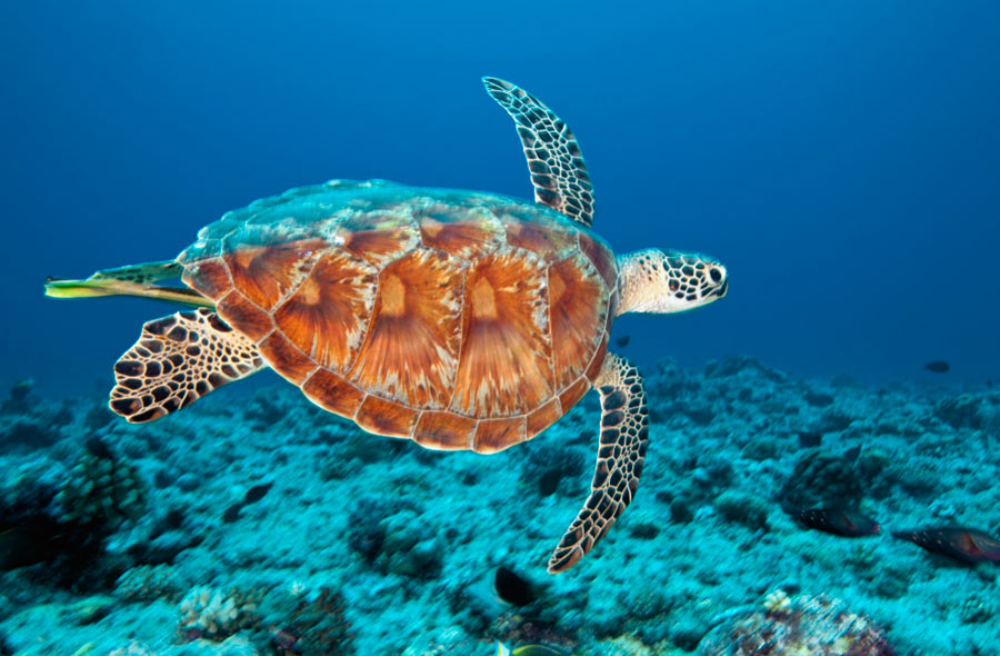In the vast expanse of the world’s oceans, few creatures capture the imagination quite like the Green Sea Turtle (Chelonia mydas). With its graceful movements through the water and distinctive emerald-hued carapace, this ancient reptile holds a special place in the hearts of conservationists, researchers, and nature enthusiasts alike. As one of the largest sea turtle species, the Green Sea Turtle plays a vital role in marine ecosystems and serves as an indicator of the health of our oceans. In this article, we delve into the fascinating world of the Green Sea Turtle, exploring its biology, behavior, conservation status, and the challenges it faces in today’s changing world.
Anatomy and Physiology of the Green Sea Turtle
The Green Sea Turtle is named for the color of its fat, rather than its shell, which can vary from olive to black. Their carapace, or shell, is streamlined and relatively flat compared to other sea turtle species, allowing them to navigate the ocean currents with ease. Adult Green Sea Turtles can reach impressive lengths of up to four feet (120 cm) and weigh as much as 700 pounds (317 kg), with females generally being larger than males.
One of the most distinctive features of the Green Sea Turtle is its serrated jaw, which is perfect for grazing on seagrasses and algae. Unlike other sea turtles, which have a more varied diet, Green Sea Turtles are primarily herbivorous, making them crucial ecosystem engineers in maintaining the health of seagrass beds and coral reefs.
Lifecycle and Behavior
Green Sea Turtles lead remarkable lives that span vast distances across the world’s oceans. They are popular for their incredible navigational abilities, often traveling thousands of miles between their nesting beaches and feeding grounds. Female Green Sea Turtles return to the beaches where they were born to lay their eggs, a behavior known as natal homing. After a lengthy and arduous journey, females haul themselves onto the sandy shores to dig nests and deposit clutches of eggs, which they then cover with sand before returning to the ocean.
The journey of the hatchlings is equally perilous, as they must evade predators and navigate the treacherous waters of the open ocean. Those that survive the gauntlet eventually settle in coastal habitats, where they spend their early years feeding and growing before joining the ranks of adult turtles in the open ocean.
Conservation Status of Green Sea Turtle
Despite their remarkable adaptations and resilience, Green Sea Turtles face numerous threats that jeopardize their survival. Historically, people hunted these turtles for their meat, eggs, and shells, leading to significant population declines around the world. Although hunting is now banned in many countries, illegal poaching still occurs in some regions, particularly for their eggs, which are considered a delicacy in certain cultures.
Additionally, habitat loss, pollution, climate change, and accidental capture in fishing gear pose significant challenges to Green Sea Turtle populations. The destruction of nesting beaches and feeding grounds, pollution from plastics and chemicals, and the warming of ocean waters all contribute to the decline of these majestic creatures.
Conservation efforts aimed at protecting Green Sea Turtles have made significant strides in recent decades. Strict regulations on hunting and trade, habitat restoration projects, and initiatives to reduce bycatch in fishing gear have helped stabilize some populations. Furthermore, public awareness campaigns and ecotourism initiatives have fostered greater appreciation for these turtles and their habitats, driving support for conservation measures.
Looking to the Future
While there is a progress in safeguarding Green Sea Turtles, much work remains to ensure their long-term survival. Continued efforts to mitigate the impacts of climate change, reduce plastic pollution, and protect critical habitats are essential for the conservation of these iconic marine reptiles. Moreover, collaboration between governments, conservation organizations, scientists, and local communities is crucial for implementing effective conservation strategies and promoting sustainable practices.
As we strive to protect the Green Sea Turtle and other marine species, we must recognize the interconnectedness of all life in the ocean. By safeguarding these ancient creatures and the ecosystems they inhabit, we not only preserve the biodiversity of our planet but also secure a healthier future for generations to come. The Green Sea Turtle serves as a poignant reminder of the profound beauty and fragility of our oceans, inspiring us to take action and become stewards of the sea.










